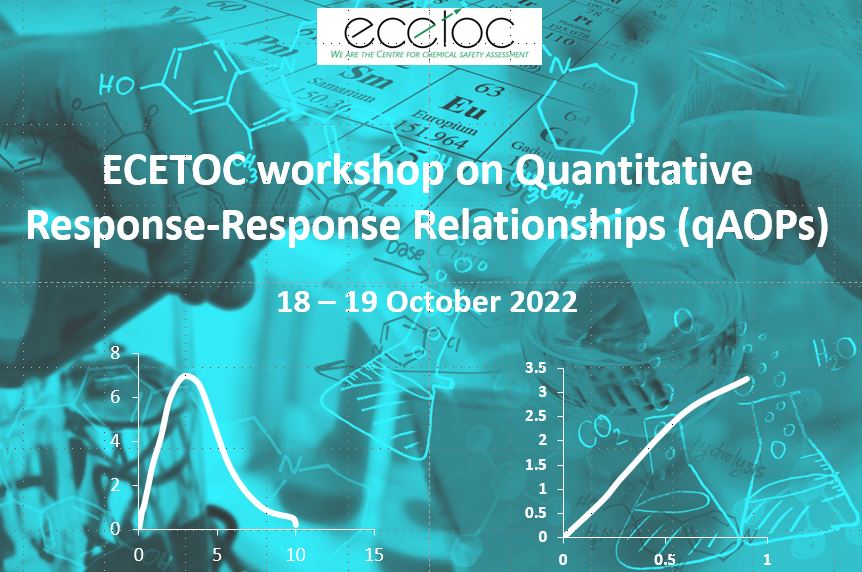Workshop on Quantitative Response-Response Relationships (qAOPs)
This event is by invitation only.
For more information, please contact info@ecetoc.org
Workshop background
Adverse Outcome Pathways (AOPs) provide a framework for curating and organising toxicological & ecotoxicological knowledge with associated measurements of key events and the dose & temporal concordance of relationships between these events. AOPs have been the topic of many conferences and workshops since the concept was first proposed in 2010. To date these qualitative AOPs have made little impact in regulatory toxicology beyond simple chemical reactivity-driven endpoints. However, quantitative AOPs are likely to be significantly more impactful in next generation risk assessments using new approach methods without the need to conduct animal studies. There is, though little guidance on best practices for quantitative AOP generation.
There are several published tiered frameworks for conducting next generation risk assessments using human-focused in vitro experimentation and in silico modelling of both biological effects and pharmacokinetics to provide estimates of human bioactive doses. A minimally toxic in vitro exposure is derived from this perturbation of human biological effects using a panel of in vitro assays. This is then converted into a human effective dose estimate using in silico physiologically based pharmacokinetic models, which can also be parameterized by in vitro assays. This combination thus provides an estimate of a point of departure for human effects that can be used as an endpoint in a risk assessment and derivation of a health-based guidance value. This is often presented, using the premise that biological responses occur at lower doses than adverse responses, as a protective conservative first tier and is performed without regard for whether the biological perturbation is large enough to cause, or even can cause, an adverse outcome.
If there isn’t sufficient margin of exposure to ensure safety, even after risk management to reduce exposures, higher tier refinements are recommended to identify adverse points of departure. However, performing such higher tier risk assessments critically depends on having knowledge of the pathway between exposure and adverse outcome to ensure this pathway is adequately modelled within the in vitro and in silico approaches. The development of a quantitative Adverse Outcome Pathways (AOPs) from these data could bridge this gap.
However, there are several issues with using the existing AOP framework as the underpinning to a higher tier risk assessment:
- Existing AOPs provide incomplete coverage of all potential toxicities, and our knowledge of all toxic mechanisms is also incomplete. Therefore, in these circumstances it isn’t clear how to address prediction of adversity using only in vitro and in silico methods.
- Current and emerging regulatory concerns (such as for developmental neurotoxicity) often require us to predict effects in humans where there are no established in vivo model systems, but panels of potentially mechanistically relevant human in vitro assays have or are being developed. However, the relationship of these in vitro assays to human effects is not clear.
- Perhaps most importantly, existing AOPs are not quantitative. The Molecular Initiating Event (MIE) is the foundational event, but for most MIEs the quantitative threshold triggering the downstream key biological events leading to adversity are unknown. Equally, the ability to describe a quantitative AOP from MIE to subsequent key biological events using only in vitro and in silico approaches is unproven.
Workshop objectives
- To bring together different stakeholders to build on the knowledge gained from existing experience of qAOP generation.
- To make recommendations that will enable the design, interpretation and application of Quantitative Response-Response Relationships based on qualitative/descriptive AOPs that are trusted to provide confidence in use in decision making.
- Emphasis will be placed on the development of open standards to support the FAIRification of qAOP.
Workshop presentations
- WS introduction_Ben van Ravenzwaay
- Considerations for increasing quantitative AOP (qAOP)regulatory uptake_Magda Sachana (OECD)
- An evolving view of QAOP and considerations for application_Dan Villeneuve (US EPA)
- Supporting Regulatory Application of AOPs_Bette Meek (Univeristy of Ottawa)
- Quantitative systems modeling of qAOP and its data integration - ONTOX perspective_Huan Yang (esqLABS)
- Identifying molecular biomarkers of a chemical hazard using new approach methodologies_Albert Zhou (University of Birmingham)
- Acute-to-chronic extrapolation in vitro. Implications for the development of KERs_Peter Macko (EC JRC)
- Quantitative adverse outcome pathway (qAOP) models for toxicity prediction_Nicoleta Spïnu (Liverpool John Moores University)
- A Machine-Readable AOP Evidence Data Model: Enhanced data input and retrieval from the AOPwiki_Jason O'Brien ( Environment and Climate Change Canada)
- Case study 1: The state of the art in AgChem – an example using HPPD inhibitors_Steven Webb (Syngenta)
- Case study 3: Identifying thyroid hormone disruptors by establishing qAOPs integrating cross-species extrapolations and thresholds_Stephanie Melching-Kollmuss (BASF)
- Recap of Day 1 and introduction to the breakout groups_Richard Currie (Syngenta)
- Breakout Group 2_Summary
- Breakout Group 3_Summary
- Breakout Group 4_Summary
- Toxicological Sciences (SOT) - Journal article: "How Adverse Outcome Pathways Can Aid the Development and Use of Computational Prediction Models for Regulatory Toxicology", Wittwehr et al., 2017

